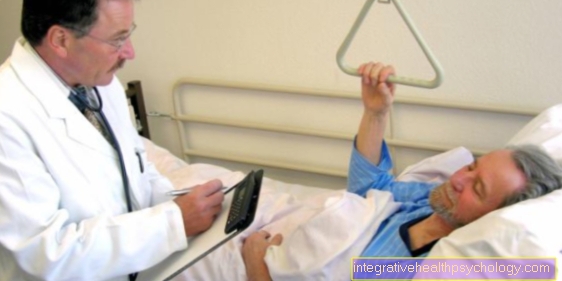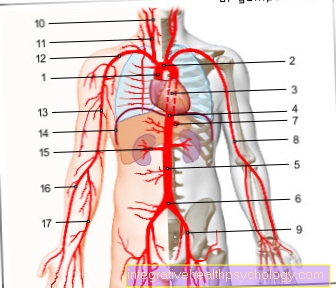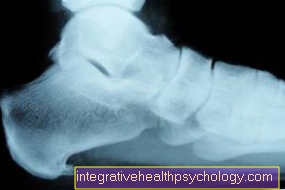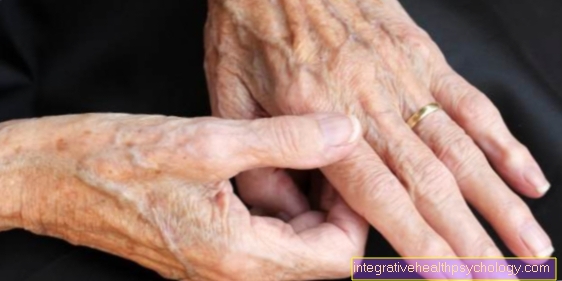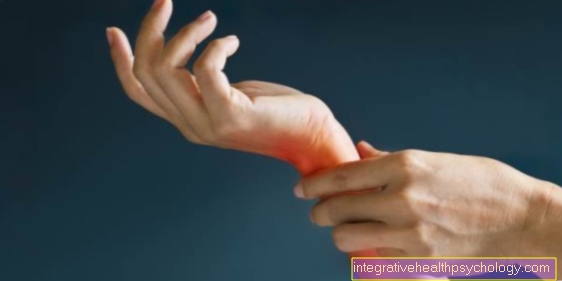Ischial fracture
introduction
A ischial bone fracture describes the breakage of the Ischium (lat. Os ischii) in one or more places. The fractions are divided into upper and lower ischial bone fractures, as well as stable and unstable fractures.
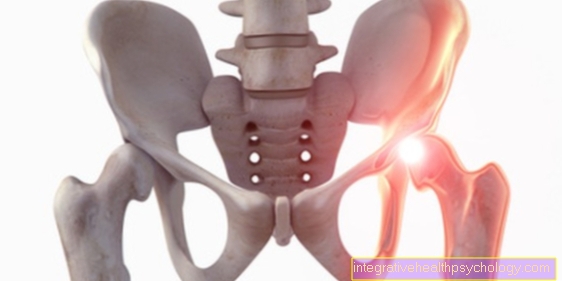
In a stable fracture, there is usually only one break in one place and there are no displaced fragments, in contrast to the unstable fracture. Like all fractures of the pelvic bone, the ischial bone fracture is a serious injury that should definitely be examined by a doctor.
causes
Like the entire human pelvis, the ischium is a very stable bone. Strong forces have to act so that a break can occur. One cause is traffic accidents at high speed, for example when a pedestrian is hit by a car. A fall from a great height can also result in a ischial bone fracture.
In sport, a muscle that arises from the ischium can tear out a piece of its bony anchorage under strong tension. This injury, known as an avulsion fracture, is rare and particularly affects young, growing athletes. There are also some conditions that weaken bones and make them more prone to breakage. These include osteoporosis, which mostly affects older women, as well as various cancers, which are, however, much rarer.
Read more on the topic: osteoporosis
If a bone is weakened by a corresponding disease, even smaller forces are sufficient in a so-called minor trauma to lead to a ischial bone fracture.
Also read on this topic: Ischial tuberosity pain
Symptoms
The ischium fracture is often accompanied by severe pain that can radiate into the buttocks. Usually a Relieving posture taken, in which the hip is bent and the affected side is relieved as much as possible. Every movement and load on the hip makes the pain noticeably worse.
Unstable fractures with moving bone parts can create a feeling of bone rubbing. Organs, blood vessels and nerves can also be damaged in the course of the accident. As a result, there may be bleeding from the anus, urethra, or vagina, or pain radiating to the abdomen. If a nerve is damaged, parts of the skin over the hips or in the legs and feet can be numb, or muscles can be paralyzed or weak.
Also, a nerve injury can lead to a Urinary incontinence to lead. Bleeding can cause a bruise behind the organs and cause pain in the lumbar spine. Are larger vessels, e.g. In the leg or pelvis, injured, the high blood loss can also lead to dizziness and fainting.
Appointment with ?

I would be happy to advise you!
Who am I?
My name is dr. Nicolas Gumpert. I am a specialist in orthopedics and the founder of .
Various television programs and print media report regularly about my work. On HR television you can see me every 6 weeks live on "Hallo Hessen".
But now enough is indicated ;-)
In order to be able to treat successfully in orthopedics, a thorough examination, diagnosis and a medical history are required.
In our very economic world in particular, there is too little time to thoroughly grasp the complex diseases of orthopedics and thus initiate targeted treatment.
I don't want to join the ranks of "quick knife pullers".
The aim of any treatment is treatment without surgery.
Which therapy achieves the best results in the long term can only be determined after looking at all of the information (Examination, X-ray, ultrasound, MRI, etc.) be assessed.
You will find me:
- Lumedis - orthopedic surgeons
Kaiserstrasse 14
60311 Frankfurt am Main
You can make an appointment here.
Unfortunately, it is currently only possible to make an appointment with private health insurers. I hope for your understanding!
For more information about myself, see Lumedis - Orthopedists.
Pain in a ischial fracture
Basically, long-lasting pain must be expected after a ischial fracture. If such a stable bone is broken, it takes a correspondingly long time for it to heal, which causes pain for the patient (see also: Pain in the ischium). Concomitant injuries to nerves can also trigger painful abnormal sensations or hypersensitivity to touch or high and low temperatures.
How long you have to suffer from the pain varies from person to person and depends on the severity of the injury and other damaged structures. The type of therapy also affects the duration of the symptoms. However, it is possible that pain may persist six to eight months after a ischium fracture. Complex Regional Pain Syndrome (CRPS) is a complication that can generally occur with bony injuries. This is impaired wound healing in the injured tissue, which leads to chronic pain that is difficult to control. However, it is very rare.
Read more on the topic: CRPS
diagnosis
Most ischial fractures show up in the X-ray image as fracture lines or displaced bone fragments. If there is a suspicion of an injury to the internal organs of the abdomen or pelvis, an CT - or MRI- Admission may be necessary in order to safely find and treat the injury. A urine test and a cystoscopy are indicative of an injury to the urogenital tract, as is palpation of the prostate in men. A pelvic exam should also be done, especially in pregnant women. If an elderly person falls slightly, a disturbed pain sensation and the atypical accident mechanism can make it difficult to find the break.
therapy
Depending on the type and severity of the injury, the therapy must be adjusted accordingly. Avulsion fractures often only require one Immobilization and Painkiller. Stable fractures can be treated with walking aids for relief. A pain-adapted load should be used in which the patient only makes movements that do not hurt him.
Unstable fractures need a operative care. The bone pieces are brought into their correct position in an open operating theater or with a system of weights from the outside and then attached with wires, nails, screws or plates. In any case, physiotherapy as quickly as possible is important, and should be maintained for a comparatively long time after the accident. Consistent pain therapy must be carried out.
Depending on the severity of the pain, you can take anti-inflammatory drugs like Ibuprofen up to Opioids be necessary. Opioids are powerful drugs and have quite high side effects and are highly addictive, which is why they should not be given long-term. Medication must be taken during immobilization Blood thinning be taken.
physical therapy
In general, physiotherapy should begin as early as possible with a pain-adapted exercise. The patients train under professional supervision as best their position allows, without causing pain. This prevents excessive muscle breakdown and misalignment of the joints. The pain improves and there is an effective protection against Thrombosis and Pneumoniathat can meet elderly, bedridden patients. In addition, the risk of one is permanently reduced disturbed gait or a chronic one Feeling of instability.
Duration
How long it takes for the fracture of the ischium to heal completely cannot be said in general terms. The factors that speak in favor of a rather rapid healing include a light and uncomplicated injury pattern, the young age of the patient and physiotherapy that was started early and consistently carried out.
Depending on the severity of the injury and the therapy carried out, walking aids are prescribed for weight relief for about 6-12 weeks after the accident. The duration of the physiotherapy also varies, but will normally be several months. The bony healing process is complete around 3 - 4 months after the accident; until, however, ideally, all complaints have subsided, there is no more pain and strength and normal body sensation have completely returned up to one year pass away.








